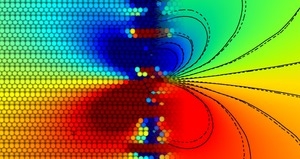Modeling of Dislocation – Grain Boundary Interactions

Amorphous, inorganic materials can show extremely high strengths but usually suffer from very limited fracture toughness. The recent years have seen a rising The glide of dislocations and their interaction with obstacles determines the plastic deformation of metals. Structural materials usually consist of many crystallites (“grains”) of different orientations. The boundaries between these grains are strong obstacles to the propagation of slip.
In this project we use atomistic simulations to study in detail the interaction of dislocations with grain boundaries and to characterize grain boundaries with respect to their propensity to absorb or transmit lattice dislocations. In particular, the topology of the grain boundaries is studied in relation to the dislocation type and character. This information can be used to develop better mesoscale and continuum models of (nano-)polycrystal plasticity.
This project started as a collaboration with the Institute of Materials Simulation at the FAU and Dr. Katerina Aifantis (MINATRAN ERC Starting Grant), which now has ended. The study of dislocation – grain boundary interaction is, however, still an active area of research in our group, especially in the context of nanocrystalline materials. (See also Plastic deformation and failure of nanostructured metals)
Related Publications
- A. Prakash, D. Weygand, E. Bitzek [2017], Influence of grain boundary structure and topology on the plastic deformation of nanocrystalline aluminum as studied by atomistic simulations, International Journal of Plasticity 97 107 Link to paper
- T. Klöffel, E. Bitzek, B. Meyer [2015], Impact of twin boundaries on bulk elastic constants, Data in Brief 3 209 Link to paper